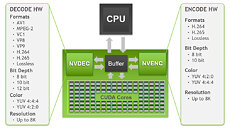
AMD Radeon RX 9070 and 9070 XT Official Performance Metrics Leaked, +42% 4K Performance Over Radeon RX 7900 GRE
AMD's internal benchmarks of its upcoming RDNA 4-based RX 9070 series graphics cards have been leaked, thanks to VideoCardz. The flagship RX 9070 XT delivers up to 42% better performance than the Radeon RX 7900 GRE at 4K resolution across a test suite of over 30 games, with the standard RX 9070 showing a 21% improvement in the same scenario. The performance data, encompassing raster and ray-traced titles at ultra settings, positions the RX 9070 series as a direct competitor to NVIDIA's RTX 4080 and RTX 5070 Ti. Notably, AMD's testing methodology focused on native rendering and ray tracing capabilities rather than upscaling technologies like FSR. The RX 9070 XT demonstrated large gains at 4K resolution, achieving a 51% performance uplift compared to the two-generations older RX 6900 XT. Meanwhile, the base RX 9070 model showed a 38% improvement over the RX 6800 XT at 4K with maximum settings enabled.
While AMD confirms its new cards are designed to compete with NVIDIA's RTX 50 series, specific comparative benchmarks against the RTX 5070 Ti were absent from the presentation. AMD acknowledges it has yet to acquire the competitor's hardware for testing. The company is expected to provide a comprehensive performance overview, potentially including additional GPU comparisons, during its official announcement on February 28. Both RX 9070 series cards will feature 16 GB of VRAM, matching the memory configuration of the RX 7900 GRE used as a primary comparison point. By the official launch date, AMD will have time to push final driver tweaks for optimal performance. Nonetheless, more information will surface as we near the official release date.
While AMD confirms its new cards are designed to compete with NVIDIA's RTX 50 series, specific comparative benchmarks against the RTX 5070 Ti were absent from the presentation. AMD acknowledges it has yet to acquire the competitor's hardware for testing. The company is expected to provide a comprehensive performance overview, potentially including additional GPU comparisons, during its official announcement on February 28. Both RX 9070 series cards will feature 16 GB of VRAM, matching the memory configuration of the RX 7900 GRE used as a primary comparison point. By the official launch date, AMD will have time to push final driver tweaks for optimal performance. Nonetheless, more information will surface as we near the official release date.



























































